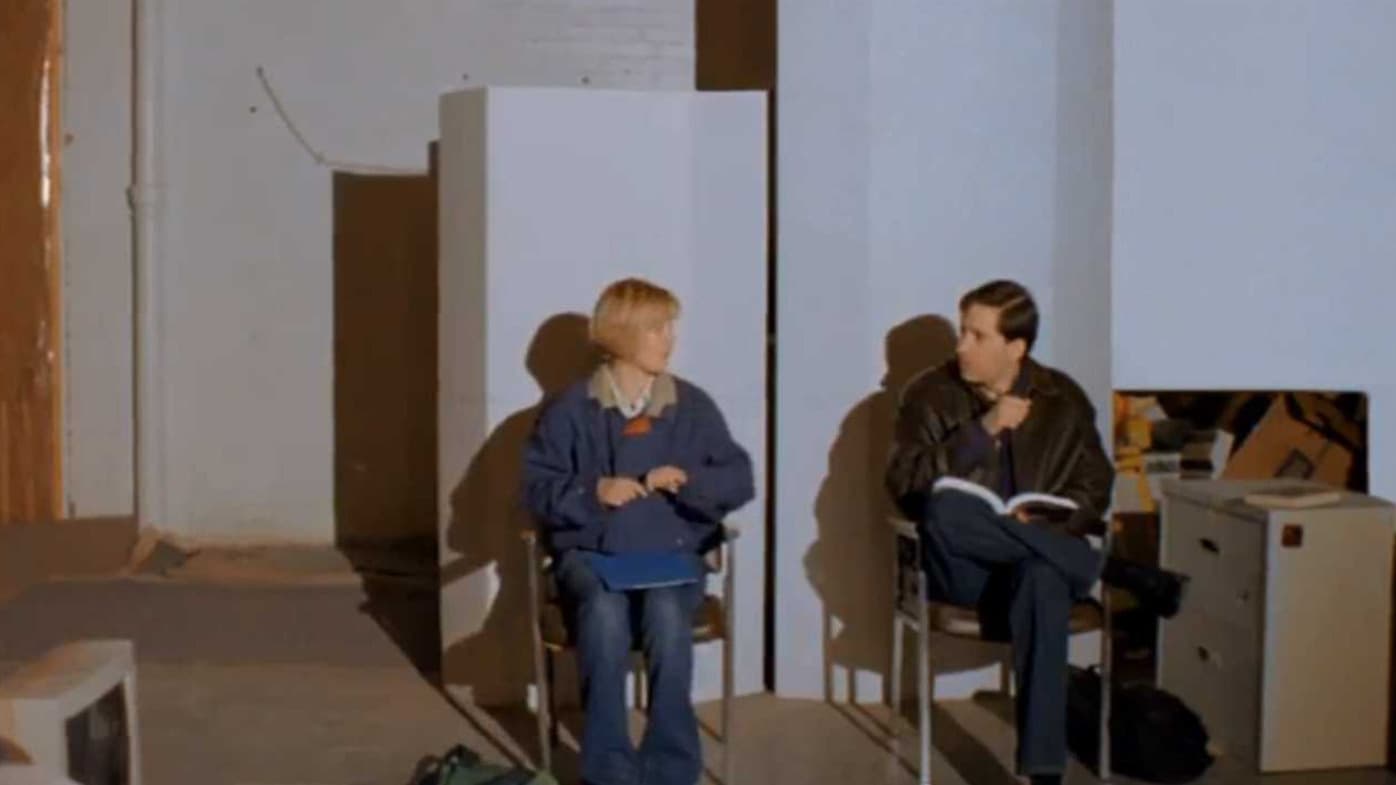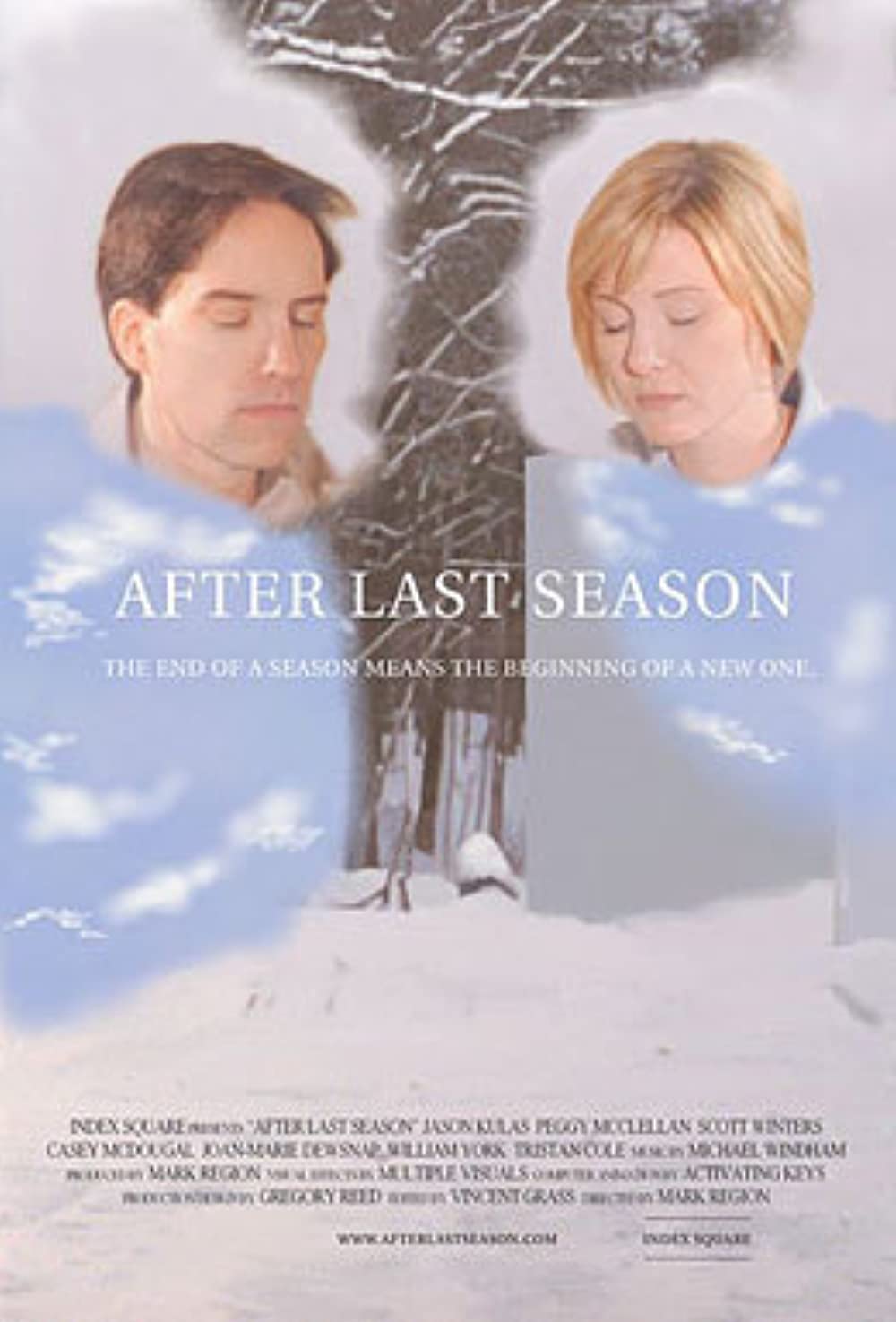
For every thing there is a season
A review requested by Andrew, with thanks to supporting Alternate Ending as a donor through Patreon.
Do you have a movie you'd like to see reviewed? This and other perks can be found on our Patreon page!
Officially, the 2009 independent psychological sci-fi thriller After Last Season cost $5 million dollars, which is both a lot of money and not very much money at all. You can make a movie off of $5 million, for sure, but it can't be a big movie, not in 2009 anyway, and this certainly isn't a big movie. But it's not "not big for $5 million". It's not even "not big for $500,000". It's "not big for a film school project", other than the fact that it's an hour and a half long. Damn near everything that happens in the film happens in a featureless room with walls that look like generic set pieces from the local community college, as two people with no definition, played by actors who have obviously not been run through too many rehearsals, deliver miles-long exchanges of dialogue that have absolutely nothing whatsoever to do with the rest of the film. To call this low production value would be a disgusting and cruel insult to all of the clever indie directors who have made tens of thousands of dollars turn into real cinematic art.
So anyway, where did that $5 million go? Less than $50,000 into the on-set production, according to writer-director-producer Mark Region; the rest went into its CGI effects sequences. Lest you find yourself seduced into thinking this is a reasonable explanation, the CGI looks like this:

"That's not fair, Tim", you are perhaps thinking. "That's just a dreamscape of trees. There aren't even people in that shot". To which I say, fair enough.

Maybe in the early 1980s, when CGI was in its mewling infancy, I would have believed that cost real money to produce. Maybe. It doesn't look all that much better than the "Money for Nothing" video in 1985, and I have a hard time anybody was spending millions of dollars on music videos in 1985. By 2009, though, this is absolutely not even slightly plausible. This is quite literally what you would expect to see from somebody who just installed Maya on a Mac Pro and spent the day dicking around to see what they could do with it. The weekend, maybe, if they didn't want to use pre-built character rigs.
This all being the case, it's entirely unsurprising that rumors have persisted since its trailer, presenting a mangled version of the plot whispered threateningly in voiceover, snuck into the world in 2009, that this surely must be some kind of money-laundering scheme (the other rumor at the time was that it was part of a bizarre viral marketing strategy for another movie, possibly for Where the Wild Things Are; this obviously turned out to have been optimistic). And the film's very scrawny "fulfill our contractual obligation"-sized release to a grand total of four theaters (in suburban Los Angeles, New York, and Chicago, and the actual city limits of Austin) doesn't assuage one's suspiciions Certainly it would require more generosity of spirit that I can possibly imagine possessing to assume that After Last Season was actually intended to be a real movie. And not just because it looks like Region paid for it using the money he found looking for quarters in the return slots of pay phones. This is dysfunctional filmmaking at a bone-deep level, casually and viciously indifferent to anything that might be even mildly enjoyable for the viewer. Scenes are hideously overlit with strong keys and no apparent fills - wouldn't you just know, Mark Region was the cinematographer, too! - leaving big, chunky shadows slopped all over those big empty walls that make up what we're meant to believe are "sets". The camera is set up in what is frequently more of an approximation of a composition than anything else: there are low angles looking idly up at the ceiling, with the characters involved in the scene are framed from the chest up somewhere too far to the side. And at least these shots have characters. Very frequently, the film just... cuts, for no motivated reason, to images that don't actually appear to have a subject. At least a couple of times, they don't even have content, just some fragment of those plain walls painted in light blue or rose. Sometimes, the filmmakers take pity on us, and we at least are looking at, I don't know, a lamp, or appliances, or part of a door.
This leads to the film feeling almost surreally devoid of actual places; it is, at best, able to suggest the roughest idea of places through fragments of their individual elements. And even that only works sometimes, because as often as not, those random bits and pieces that the film cuts to don't even appear to be in the same room as the scene around them, as if Region accidentally ran some film through the camera while walking around the location, and didn't have enough in the budget to waste so much as a single exposed frame. So into the cut they had to go, anyplace. When he does try to actually suggest real locations, we run into the problem of, to name one example, a CT scan machine that appears to have been fashioned out of cardboard. Or an establishing shot of the outside of the "Prorolis Corporation", which is just a photograph of a nondescript concrete building, with the words "Prorolis Corporation" added by simply using the text tool and a drop shadow to imply in the most half-assed way possible that the words have been carved onto the building. I am perhaps being unfair. Perhaps it was actually video footage.

There is, buried beneath this, what purports to be a narrative. Matthew Andrews (Jason Kulas) and Sarah Austin (Peggy McClellan) are neurology students, working at the Prorolis Corporation, where they have begun using microchips implanted in their brain to help visualize their thought processes. And these thoughts are the CGI sequences - the film gamely tries to paper over the shockingly low quality of the effects by suggesting that it's very hard to get a clear image using the available technology. They use these visualization exercises to try recreating the details of a series of murders; a fellow student was stabbed to death by an assailant unknown, and Matthew and Sarah hope to catch him. Soon enough, they have discovered that their process does not merely allow them to see thoughts, but to predict the future. I think.
If I am being honest, by the time the plot was purring along in earnest- that's a lie. The plot never "purrs along in earnest". I cannot even say that there's a point where it has at least moved past the point that characters have minutes-long conversations about the most nonsensical minutia of their lives, detached in every conceivable way from the matter of a knife-wielding killer or the exciting neurology research being done at Prorolis. They talk about, like, towns they've driven through, but not stopped at. And this never really ceases to be part of the movie; the actors are quite obviously lost, with no understanding at all of how the lines they're speaking are going to fit together, and this is in part no doubt because Region just had them recite lines in large bunches from across the script, to save on changing camera set-ups. Accordingly, the film is a minefield of random bursts of arbitrary human speech.
So no, there's not even a point where the film at least starts to be about something. But there is a point where the two leads have started actively trying to solve the mystery of who's killing their colleagues, and as I started out to say last paragraph, by the time that was in full swing, my eyes were no longer able to stay pointed at After Last Season. It is too empty of a visual experience. There is nothing to grab your attention, just great big pastel voids, and when the CGI sequences come along, it somehow manages to be even worse, since they're just voids of a different sort, more effortfully made, and accompanied by dead silence on the soundtrack to give us plenty of perceptual space to really feel the cold vacuum of the blank white CGI. After a point - it came awfully early for me - one simply cannot keep paying attention. I imagine that even if I'd seen it in one of those four theatrical engagements, free from any and all distractions, I would still somehow have been paying more attention to the sound of the blood pumping behind my ears or the low rumble of air rushing in and out of my nose. After Last Season literally cannot be watched. One's body simply refuses to absorb it, like accidentally eating a small piece of plastic.
So maybe, just maybe, the script makes more sense than I'm giving it credit for. After too many conversations about small towns that nobody speaking had ever been to, but they'd heard about it, the words of the dialogue are replaced by a droning throb. I think it is fair to assume that none of this makes sense, especially given that the film uses its visual thinking machines as an excuse to trot out some "what is a dream and what is real?" ambiguity, and I freely confess that I don't have any idea what might be the answer to that question.
The point of all this is, After Last Season is genuinely cruel bad cinema. There's a certain astonishment to be had in watching it, the sick appeal of seeing every single fundamental of the filmmaking process going all the way wrong; it's actually not possible to understand just how alien this is to any form of art-making I have ever encounterd until you subject yourself to the footage firsthand. But it's not fun to do that; this is definitely not a so-bad-it's-good movie. It's not even so-bad-it's-bad. It's like forcibly giving yourself a migraine, a film so vindictively ugly and confusing that merely trying to parse it as cinematic storytelling makes your head feel blurry and hot.
Do you have a movie you'd like to see reviewed? This and other perks can be found on our Patreon page!
Officially, the 2009 independent psychological sci-fi thriller After Last Season cost $5 million dollars, which is both a lot of money and not very much money at all. You can make a movie off of $5 million, for sure, but it can't be a big movie, not in 2009 anyway, and this certainly isn't a big movie. But it's not "not big for $5 million". It's not even "not big for $500,000". It's "not big for a film school project", other than the fact that it's an hour and a half long. Damn near everything that happens in the film happens in a featureless room with walls that look like generic set pieces from the local community college, as two people with no definition, played by actors who have obviously not been run through too many rehearsals, deliver miles-long exchanges of dialogue that have absolutely nothing whatsoever to do with the rest of the film. To call this low production value would be a disgusting and cruel insult to all of the clever indie directors who have made tens of thousands of dollars turn into real cinematic art.
So anyway, where did that $5 million go? Less than $50,000 into the on-set production, according to writer-director-producer Mark Region; the rest went into its CGI effects sequences. Lest you find yourself seduced into thinking this is a reasonable explanation, the CGI looks like this:
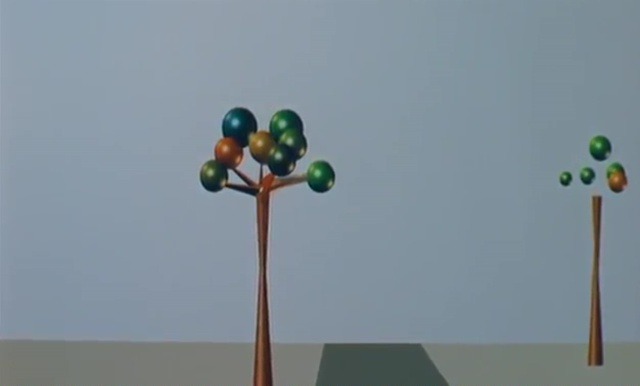
"That's not fair, Tim", you are perhaps thinking. "That's just a dreamscape of trees. There aren't even people in that shot". To which I say, fair enough.
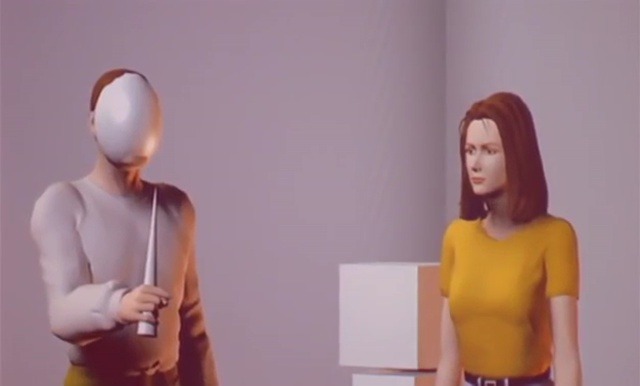
Maybe in the early 1980s, when CGI was in its mewling infancy, I would have believed that cost real money to produce. Maybe. It doesn't look all that much better than the "Money for Nothing" video in 1985, and I have a hard time anybody was spending millions of dollars on music videos in 1985. By 2009, though, this is absolutely not even slightly plausible. This is quite literally what you would expect to see from somebody who just installed Maya on a Mac Pro and spent the day dicking around to see what they could do with it. The weekend, maybe, if they didn't want to use pre-built character rigs.
This all being the case, it's entirely unsurprising that rumors have persisted since its trailer, presenting a mangled version of the plot whispered threateningly in voiceover, snuck into the world in 2009, that this surely must be some kind of money-laundering scheme (the other rumor at the time was that it was part of a bizarre viral marketing strategy for another movie, possibly for Where the Wild Things Are; this obviously turned out to have been optimistic). And the film's very scrawny "fulfill our contractual obligation"-sized release to a grand total of four theaters (in suburban Los Angeles, New York, and Chicago, and the actual city limits of Austin) doesn't assuage one's suspiciions Certainly it would require more generosity of spirit that I can possibly imagine possessing to assume that After Last Season was actually intended to be a real movie. And not just because it looks like Region paid for it using the money he found looking for quarters in the return slots of pay phones. This is dysfunctional filmmaking at a bone-deep level, casually and viciously indifferent to anything that might be even mildly enjoyable for the viewer. Scenes are hideously overlit with strong keys and no apparent fills - wouldn't you just know, Mark Region was the cinematographer, too! - leaving big, chunky shadows slopped all over those big empty walls that make up what we're meant to believe are "sets". The camera is set up in what is frequently more of an approximation of a composition than anything else: there are low angles looking idly up at the ceiling, with the characters involved in the scene are framed from the chest up somewhere too far to the side. And at least these shots have characters. Very frequently, the film just... cuts, for no motivated reason, to images that don't actually appear to have a subject. At least a couple of times, they don't even have content, just some fragment of those plain walls painted in light blue or rose. Sometimes, the filmmakers take pity on us, and we at least are looking at, I don't know, a lamp, or appliances, or part of a door.
This leads to the film feeling almost surreally devoid of actual places; it is, at best, able to suggest the roughest idea of places through fragments of their individual elements. And even that only works sometimes, because as often as not, those random bits and pieces that the film cuts to don't even appear to be in the same room as the scene around them, as if Region accidentally ran some film through the camera while walking around the location, and didn't have enough in the budget to waste so much as a single exposed frame. So into the cut they had to go, anyplace. When he does try to actually suggest real locations, we run into the problem of, to name one example, a CT scan machine that appears to have been fashioned out of cardboard. Or an establishing shot of the outside of the "Prorolis Corporation", which is just a photograph of a nondescript concrete building, with the words "Prorolis Corporation" added by simply using the text tool and a drop shadow to imply in the most half-assed way possible that the words have been carved onto the building. I am perhaps being unfair. Perhaps it was actually video footage.
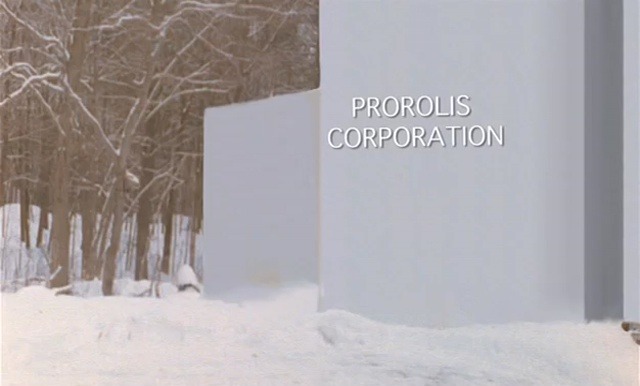
There is, buried beneath this, what purports to be a narrative. Matthew Andrews (Jason Kulas) and Sarah Austin (Peggy McClellan) are neurology students, working at the Prorolis Corporation, where they have begun using microchips implanted in their brain to help visualize their thought processes. And these thoughts are the CGI sequences - the film gamely tries to paper over the shockingly low quality of the effects by suggesting that it's very hard to get a clear image using the available technology. They use these visualization exercises to try recreating the details of a series of murders; a fellow student was stabbed to death by an assailant unknown, and Matthew and Sarah hope to catch him. Soon enough, they have discovered that their process does not merely allow them to see thoughts, but to predict the future. I think.
If I am being honest, by the time the plot was purring along in earnest- that's a lie. The plot never "purrs along in earnest". I cannot even say that there's a point where it has at least moved past the point that characters have minutes-long conversations about the most nonsensical minutia of their lives, detached in every conceivable way from the matter of a knife-wielding killer or the exciting neurology research being done at Prorolis. They talk about, like, towns they've driven through, but not stopped at. And this never really ceases to be part of the movie; the actors are quite obviously lost, with no understanding at all of how the lines they're speaking are going to fit together, and this is in part no doubt because Region just had them recite lines in large bunches from across the script, to save on changing camera set-ups. Accordingly, the film is a minefield of random bursts of arbitrary human speech.
So no, there's not even a point where the film at least starts to be about something. But there is a point where the two leads have started actively trying to solve the mystery of who's killing their colleagues, and as I started out to say last paragraph, by the time that was in full swing, my eyes were no longer able to stay pointed at After Last Season. It is too empty of a visual experience. There is nothing to grab your attention, just great big pastel voids, and when the CGI sequences come along, it somehow manages to be even worse, since they're just voids of a different sort, more effortfully made, and accompanied by dead silence on the soundtrack to give us plenty of perceptual space to really feel the cold vacuum of the blank white CGI. After a point - it came awfully early for me - one simply cannot keep paying attention. I imagine that even if I'd seen it in one of those four theatrical engagements, free from any and all distractions, I would still somehow have been paying more attention to the sound of the blood pumping behind my ears or the low rumble of air rushing in and out of my nose. After Last Season literally cannot be watched. One's body simply refuses to absorb it, like accidentally eating a small piece of plastic.
So maybe, just maybe, the script makes more sense than I'm giving it credit for. After too many conversations about small towns that nobody speaking had ever been to, but they'd heard about it, the words of the dialogue are replaced by a droning throb. I think it is fair to assume that none of this makes sense, especially given that the film uses its visual thinking machines as an excuse to trot out some "what is a dream and what is real?" ambiguity, and I freely confess that I don't have any idea what might be the answer to that question.
The point of all this is, After Last Season is genuinely cruel bad cinema. There's a certain astonishment to be had in watching it, the sick appeal of seeing every single fundamental of the filmmaking process going all the way wrong; it's actually not possible to understand just how alien this is to any form of art-making I have ever encounterd until you subject yourself to the footage firsthand. But it's not fun to do that; this is definitely not a so-bad-it's-good movie. It's not even so-bad-it's-bad. It's like forcibly giving yourself a migraine, a film so vindictively ugly and confusing that merely trying to parse it as cinematic storytelling makes your head feel blurry and hot.

